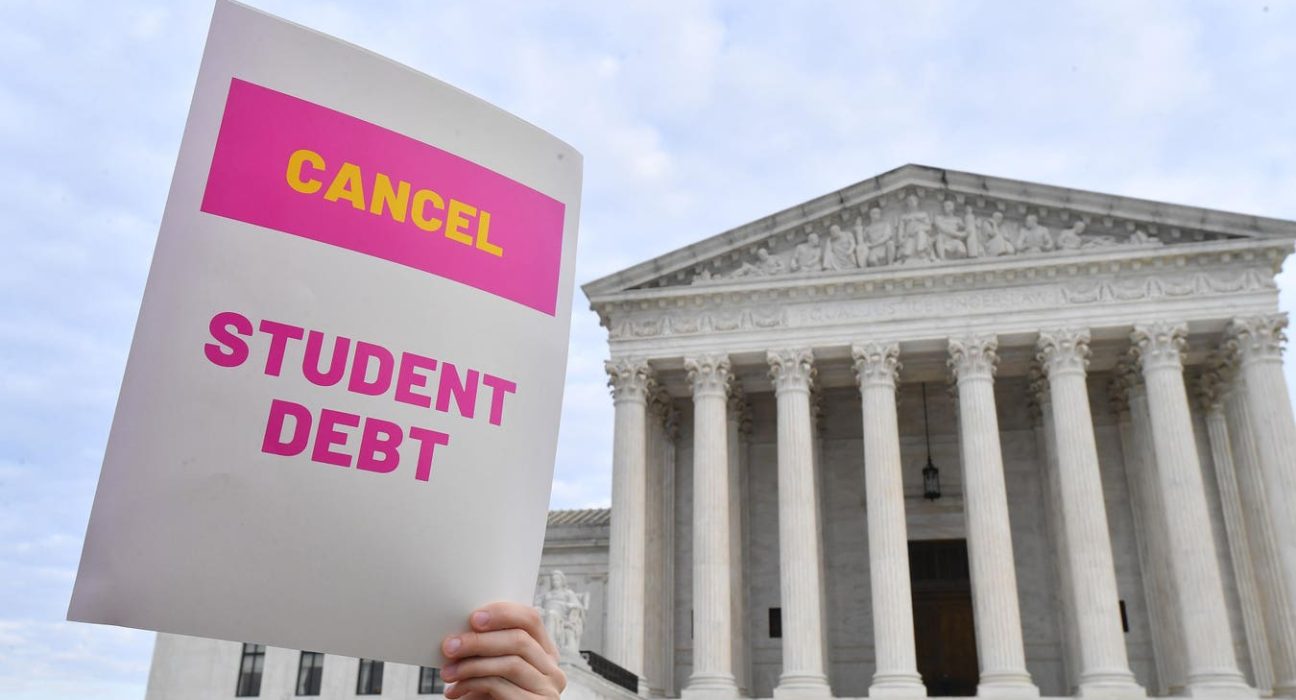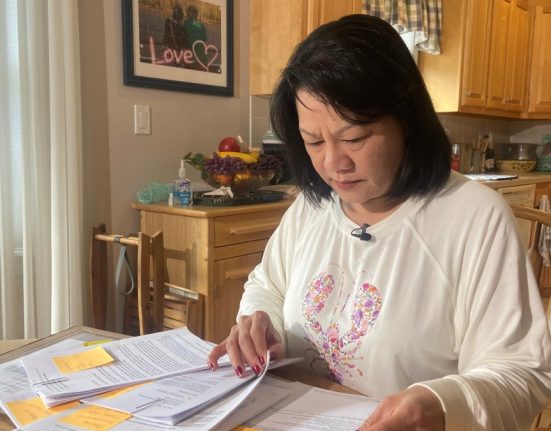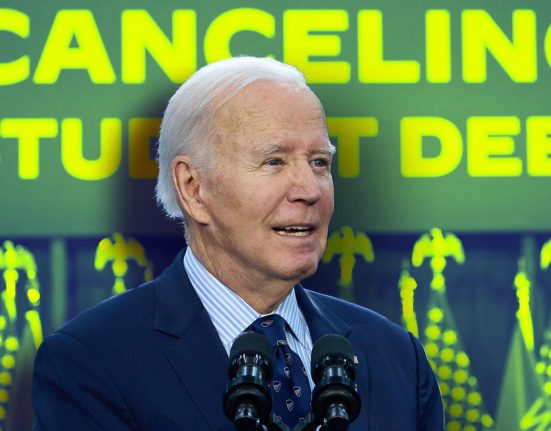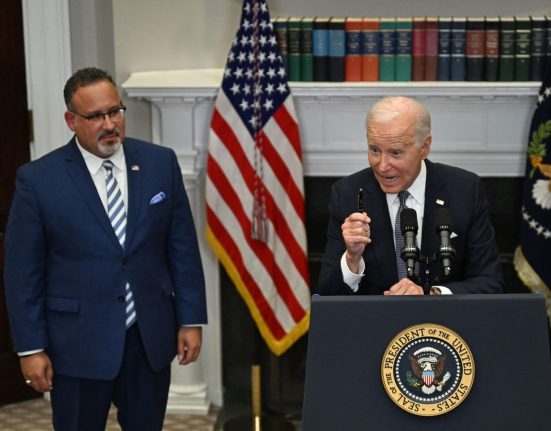WASHINGTON, DC – JANUARY 02: Student loan borrowers gathered at the Supreme Court today to tell the … [+]
Last week, the Education Department announced yet another component of President Biden’s expansive student loan cancellation agenda. The new plan, which aims to forgive debt only for borrowers who meet certain conditions, is expected to cost around $150 billion. That makes it one of the less expensive planks of Biden’s forgiveness bonanza. But it also serves to highlight how the federal student loan program is in dire need of reform.
To back up, President Biden’s signature loan-cancellation plan, which would have discharged up to $20,000 in debt for almost all borrowers, failed to survive a Supreme Court ruling in June 2023. Biden vowed to come back with a Plan B. But Plan B has actually become several plans, including an expansion of income-based loan repayment programs and a forthcoming proposal to forgive debts for borrowers experiencing a “economic hardship.” Both of those plans have price tags in the hundreds of billions.
By contrast, at less that $150 billion, the latest scheme is a comparative bargain—but still fiscally significant. In a bid to avoid the same fate that befell President Biden’s first loan cancellation attempt, it relies on a novel (though still dubious) legal theory and restricts benefits to borrowers who meet certain conditions.
Before any debt can be forgiven, the public will have the opportunity to comment on the proposal, and the Education Department must read and consider these comments before finalizing the policy. Things will move fast after that, though; the White House has signaled it intends to begin cancelling debt before the November election.
What’s in the latest proposal
The loan cancellation proposal claims that the Secretary of Education has unlimited authority to cancel federal student loans, with or without going through a formal rulemaking process. The components of the proposal “neither limit the Secretary’s discretion to waive debt in other circumstances… nor do they require the Secretary to undergo rulemaking before taking any action.” In other words, the Secretary claims the authority to cancel as much debt as he wants, whenever it suits him.
Still, the Education Department feels the need to issue a formal proposal to provide “greater clarity” regarding how the Secretary may choose to wield this apparently unlimited authority. Specifically, the Secretary plans to cancel debts for borrowers who fall into one of four categories:
- Borrowers who owe more on their loans today than they did upon entering repayment. By default, all borrowers whose balances have risen will see up to $20,000 of their accrued interest forgiven, while borrowers below a certain income threshold who enrolled in income-based repayment plans will see all of their accrued interest forgiven. This will be a one-time rather than ongoing cancellation of interest, though other Biden administration policies will waive interest on an ongoing basis.
- Borrowers who entered repayment before July 1, 2000 will see their balances completely cancelled. Those who have only undergraduate loans and entered repayment before July 1, 2005 will also see their full balances cancelled. This will also be a one-time cancellation, though again other policies will ensure that most borrowers who have owed their loans for more than 25 years will see forgiveness.
- Borrowers whom the Education Department determines might qualify for an already-established means of loan forgiveness, but have not applied. Specifically, borrowers whose schools closed while they were still enrolled, and borrowers who might qualify for forgiveness under an income-based repayment plan, would qualify for full loan cancellation under this provision. Cancellations under this provision will be ongoing.
- Borrowers who took out loans to attend colleges or programs that lost eligibility to participate in federal loans due to poor student outcomes or malfeasance. This mainly refers to the Gainful Employment (GE) rule, which cuts off loans to mostly for-profit colleges where graduates have low earnings relative to their debts. If a program was on track to be expelled from federal loans under GE, but closed before that officially happened, its students will still receive loan discharges. This provision will apply to both current and future borrowers.
How big is this loan cancellation plan?
Though billed as a more targeted approach to loan cancellation, this new plan is still costly (and still probably illegal). The Biden administration may hope that the supposedly targeted nature of the policy will give it a better chance of surviving judicial review. The plan may also fare better in the court of public opinion, because many of these groups of borrowers are sympathetic.
But the plan isn’t as targeted as you might think. According to the Education Department’s calculations, 28 million borrowers will receive at least a partial loan discharge, out of around 43 million people with federal student loans. That means around two-thirds of borrowers will enjoy student loan cancellation. Several million will see their loans cancelled in full.
The plan will cost $147 billion, according to the Department. Around half of that ($73 billion) comes from the cancellation of accrued interest. Twenty-five million borrowers would get some interest cancelled, though a subset of those borrowers are also eligible for one of the provisions that cancels debt in full.
Another major source of costs are the cancellation provisions for students who borrowed to attend programs that failed to satisfy the Gainful Employment rule. The Department figures it will cancel around $12 billion for current borrowers who attended programs that failed GE in the past. But it also expects to cancel around $15 billion for borrowers who have yet to take out loans, but will attend a low-quality college and thus see their loans forgiven.
Cancelling debts for borrowers who entered repayment on their loans more than two decades ago will cost up to $31 billion. That figure includes the cost of paying private banks to discharge the student loans they hold under a now-defunct government-guaranteed lending scheme.
This component is framed as helping out borrowers who have been unable to pay back their debts over decades. But it will likely end up helping out high-salaried professionals. People who borrowed large amounts to pay for medical school or law school in the late 1990s were disproportionately likely to choose an extended 30-year repayment plan, the longest available. Forgiving their debts after 25 years will effectively wipe out the last five years of their payments, even though these individuals are in their peak earning years and could easily afford the payments. The Penn Wharton Budget Model estimates the average household income of the borrowers who will benefit from this provision is $313,000.
Altogether these policies will cost $147 billion. Though the Department has been far off on its other cost estimates, this figure strikes me as reasonable—though it does not incorporate the costs of a separate administration proposal to forgive debts for borrowers experiencing “economic hardship.” That proposal will be formalized later this year. The Committee for a Responsible Federal Budget figures that plank could cost anywhere between $100 billion and $600 billion, depending on the specifics.
What the plan says about the student loan system
Twenty-eight million borrowers will receive some loan cancellation if the plan is implemented as proposed. That is not a “targeted” plan, and neither the public nor the courts should buy proponents’ spin that it is.
But the proposal does highlight some major issues with the student loan system. Most of those 28 million borrowers will be eligible for a waiver of accrued interest, meaning their balance is higher now than when they entered repayment. In part, this is due to the myriad of avenues the government has created to let borrowers avoid paying down their loans. Borrowers can go into a long-term forbearance, where interest accrues but payments are not due. Others enroll in income-based repayment plans, where their payments may not cover interest. Others simply don’t pay their loans and default.
According to the Department’s analysis, among borrowers who entered repayment ten years ago and then saw their balances grow, the average person spent six of those ten years in non-repayment statuses (forbearance, deferment, or default) and another two years in income-based repayment. Some of that is due to the student loan payment moratorium that began in 2020, but much of it was down to “ordinary” payment avoidance methods.
With all these options to avoid paying your loans—even as interest accrues—we shouldn’t be surprised that so many people owe more than they borrowed, and that they’re angry about it. It’s a direct result of misguided government policy that freely gives out loans regardless of ability to repay, then creates plenty of options to avoid paying.
It’s true that some of the borrowers who will benefit from the administration’s plan were legitimately hurt by the higher education system, which goaded them to take on more debt than they would ever be able to repay. Around a quarter of those with outstanding student loans have defaulted at some point. Many of their colleges charged too much or provided poor financial value, then left students and taxpayers to pick up the bill.
The problem with loan cancellation as a remedy, however, is that it does nothing to ensure that the government stops making bad loans in the future. More fundamental changes to the loan program are necessary. The federal government should limit how much it allows students to borrow. Colleges using student loans should have to meet much higher outcomes standards (GE, which exempts most public and private nonprofit colleges, is far from sufficient). The repayment system should offer fewer opportunities to avoid repayment and let interest accumulate.
Unfortunately, most of this is an afterthought for the Biden administration, which prefers to just cancel debt and move on. But without deeper reforms, the federal student loan program will continue to fail borrowers and taxpayers alike.







